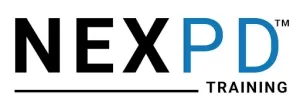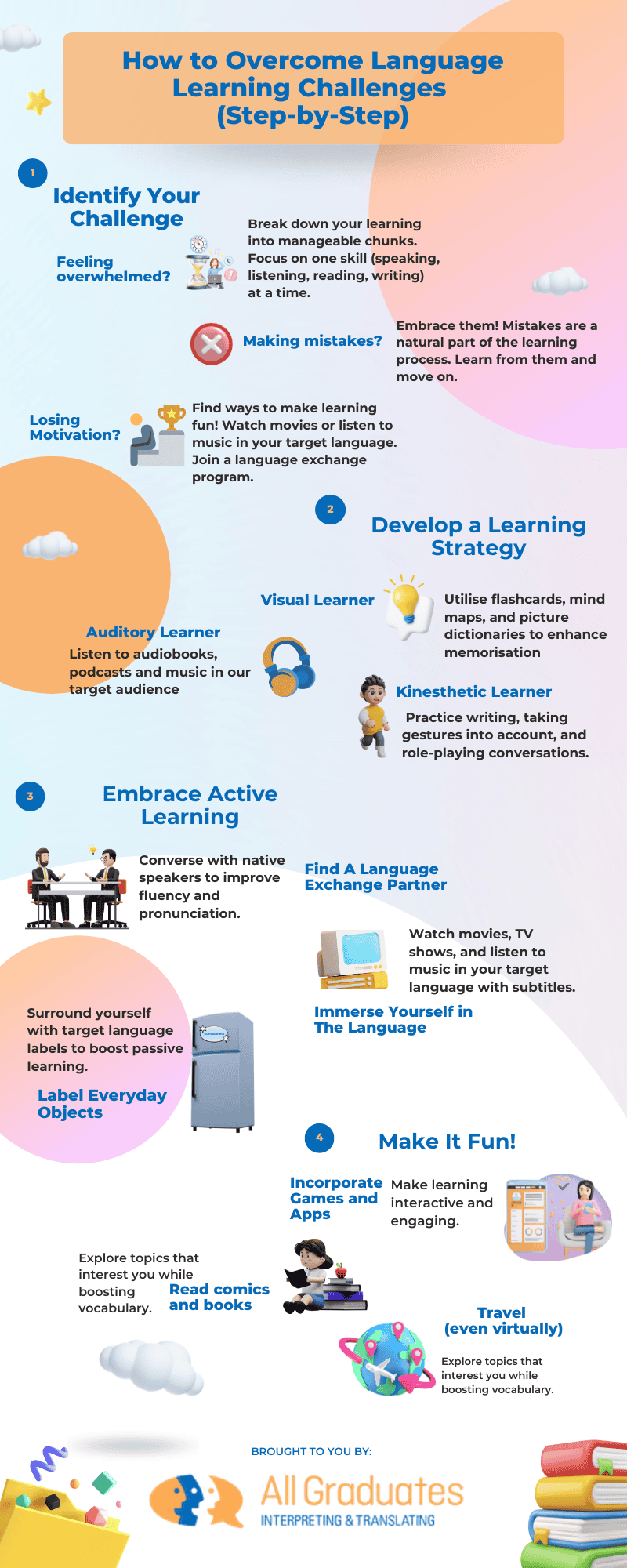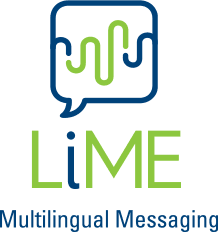Language barriers can be a thorn in the side. Whether you’re trying to order food at a foreign restaurant, or you’re giving a presentation at a global conference, not being able to speak the same language as the other person can make things really tough. How to overcome language barriers may seem to be a very daunting task.
Here’s another scenario, imagine you are a business owner planning to expand your operations into a foreign market. You have a great product or service to offer, but you quickly realize that your potential customers speak a different language. Without a way to effectively communicate your value proposition, your chances of success dwindle, right?
But fear not! In this blog, we bring you ten awesome tips on how to overcome language barriers and enhance your communication skills.
If you’re a business executive aiming to connect with global clients, a manager leading a multilingual team, or an individual seeking to improve cross-language interactions, these strategies will be your guide.
With each strategy, you’ll discover actionable tips and real-life examples that can help you break down linguistic barriers, foster meaningful connections, and achieve better outcomes in your personal and professional life. Let’s embark on this language-conquering journey together and unlock a world of possibilities.
Leaping Over The Hurdle
In our increasingly diverse world, effective communication is crucial for building relationships, fostering understanding, and achieving positive outcomes. Language barriers can often hinder communication and create challenges in both personal and professional settings. This is why it is essential to conquer these barriers by implementing practical strategies.
Language barriers can arise due to differences in language proficiency, cultural backgrounds, and communication styles. However, by equipping ourselves with the right tools and techniques, we can bridge these gaps and communicate more effectively.
 According to a study by the International Journal of Intercultural Relations, 75% of professionals believe that language barriers hurt their work. Additionally, 90% of respondents reported experiencing difficulties in understanding and being understood when communicating with colleagues from different language backgrounds.
According to a study by the International Journal of Intercultural Relations, 75% of professionals believe that language barriers hurt their work. Additionally, 90% of respondents reported experiencing difficulties in understanding and being understood when communicating with colleagues from different language backgrounds.
These statistics highlight the pervasive nature of language barriers and the urgent need for effective strategies to overcome them.
Now, let’s dive into these practical strategies and discover how they can empower you to conquer language barriers and communicate more effectively in our multicultural society.
1. Use Plain Language
When it comes to overcoming language barriers, using plain and simple language is a crucial strategy. By utilizing clear and straightforward communication, you can increase the chances of being understood by individuals who have limited proficiency in a particular language.
When using plain language, avoid jargon, technical terms, and complex sentence structures. Instead, opt for everyday words and simple sentences that are easily comprehensible across language barriers. This approach helps to bridge the communication gap and ensures that your message is effectively conveyed.
A study conducted by O’Connor et al. (2005) on fifty young, foreign-born Hispanic workers in North Carolina found that the group with little or no English ability was less likely to receive safety training than the group with basic or better English ability.
Remember, the goal is to make your content accessible and understandable to a diverse audience. By employing plain language techniques, you can enhance the clarity and effectiveness of your communication, ultimately fostering better understanding and connection.
2. Easy English For The Win!
Easy English is a concept that can greatly assist in overcoming language barriers in communication. It involves using simple language and clear sentence structures to ensure better understanding across diverse linguistic backgrounds.
By employing Easy English techniques, individuals can enhance their ability to communicate effectively, especially in multilingual environments. This approach focuses on simplifying complex information and avoiding jargon or technical terms that may be unfamiliar to non-native speakers.
By making content more accessible and understandable, Easy English promotes inclusivity and improves cross-cultural interactions. It is a valuable tool for creating clear and concise communication that transcends language barriers.
For instance, imagine you are a manager leading a team of diverse individuals, including employees who have limited proficiency in the company’s primary language. You have an important project to discuss with your team, and you want to ensure that everyone understands the objectives, tasks, and timelines involved.
Instead of using technical jargon and complex sentence structures, you choose to implement the Easy English approach. You craft a clear and concise email that outlines the project in simple terms, using everyday language that is easily understood by individuals with varying language backgrounds. You avoid using industry-specific terms and provide explanations for any necessary terminology.
By adopting this approach, you break down the language barriers that might hinder effective communication within your team. Your email is accessible to all members, regardless of their language proficiency, and allows everyone to comprehend the project requirements and expectations. As a result, your team members feel included, empowered, and ready to contribute effectively to the project’s success.
3. Slow Down, Be Clear
When communicating across language barriers, it is crucial to speak slowly and clearly. Enunciating your words and using a moderate pace can greatly enhance understanding and facilitate effective communication.
Here are some important reasons why speaking slowly and clearly is essential on how to overcome language barriers:
Improved Comprehension: Speaking slowly allows the listener to process the information more effectively, especially when they are not fluent in the language being used. By enunciating clearly, you provide them with the opportunity to grasp the intended meaning of your words.
Enhanced Listening Skills: Speaking slowly and clearly encourages active listening. It helps the listener focus on the content of the conversation, enabling them to pick up on key points and fully comprehend what is being conveyed.
Reduced Misinterpretations: Rapid speech or unclear pronunciation can lead to misunderstandings and misinterpretations. By speaking slowly and clearly, you minimize the chances of confusion and ensure that your message is accurately received.
Respect for Others: Speaking slowly and clearly demonstrates respect for individuals who might be struggling with language barriers. It shows your willingness to make an extra effort to accommodate their needs and build a connection beyond linguistic differences.
Remember, adjusting the speed and clarity of your speech can greatly assist in overcoming language barriers and fostering effective communication. By employing this simple yet powerful technique, you can bridge gaps and ensure your message is received and understood by all.
Take a page from Audrey Hepburn, and speak your words clearly.
4. Polish Your Professional Persona
Professional development plays a crucial role in enhancing communication skills and overcoming language barriers. By continuously improving their knowledge and abilities, individuals can effectively navigate cross-language interactions and foster better understanding.
Here are some key aspects of professional development that can contribute to this:
Language Training and Courses
Engaging in language training programs and courses can significantly enhance communication skills. These initiatives provide individuals with the opportunity to learn new languages or improve existing language proficiency, enabling them to communicate effectively with diverse audiences.
Cultural Competence Training
Cultural competence training equips individuals with the knowledge and understanding of cultural differences, ensuring respectful and sensitive communication across diverse backgrounds. By developing cultural competence, professionals can navigate language barriers with increased confidence and effectiveness.
Interpersonal Communication Workshops
Participating in workshops and training sessions focused on interpersonal communication can enhance language skills and provide strategies for effective cross-language interactions. These workshops offer practical techniques for overcoming language barriers and fostering meaningful connections.
Continued Learning and Networking
Continued learning within one’s field and active networking can promote exposure to diverse perspectives and language styles. Engaging in conferences, seminars, and industry events allows professionals to expand their communication skills and build relationships with individuals from different linguistic backgrounds.
Seeking Feedback and Self-Reflection
Actively seeking feedback and reflecting on one’s communication abilities are essential aspects of professional development. By evaluating their communication strengths and weaknesses, individuals can target areas for improvement and adapt their communication strategies to overcome language barriers.
Professional development empowers individuals to cultivate their communication skills, understand cultural nuances, and effectively overcome language barriers. By investing in continuous learning and growth, professionals can navigate diverse linguistic environments with confidence and achieve better communication outcomes.
Research from the University of Washington suggests a surprising benefit of bilingualism. People who speak two languages may be quicker at following new instructions. In a study published in Brain and Language, bilingual participants completed complex tasks, like “add one to x, divide y by two, and sum the results,” about half a second faster than monolinguals.
This finding hints that bilingualism might enhance executive function. This brain system controls skills like reasoning and problem-solving, and roughly 20% of Americans who are bilingual could potentially have an advantage in these areas.
Please visit our sister company NEXPD for self-paced OnDemand courses and workshops designed for bilingual workers, interpreters, and translators.
Translated resources are also great for professional development. The Find a Translation website provides over 80,000 resources covering over 200 languages from around Australia and New Zealand.
5. Let Graphics Do The Talking
Incorporating graphics is a highly effective strategy for enhancing communication in cross-language interactions. Visuals can transcend language barriers by conveying meaning and information in a universal way. By visually representing concepts, data, or instructions, graphics provide a clear and concise message that is easily understandable, regardless of language proficiency.
Who doesn’t love visuals, right? So, check out these ways how to use them effectively:
- Infographics: Present complex information or processes in a visually appealing and straightforward format.
- Icons and Symbols: Utilize icons and symbols that are universally recognized to represent concepts or actions.
- Charts and Graphs: Visualize data and statistics using charts and graphs to facilitate comprehension.
- Images: Incorporate relevant images that support the main message and evoke emotions.
Just a reminder though, always use culturally appropriate images and consider the accessibility of your graphics to ensure inclusivity. By leveraging the power of visuals, you can effectively communicate your message and overcome language barriers.
6. Repeat, Repeat… Did We Just Say “Repeat”?
Did you know that repetition has been a key element in communication for centuries? One of the earliest examples of repetition in writing can be found in ancient Egyptian hieroglyphs. These intricate symbols were often repeated to reinforce their meaning and help convey important messages.
 Today, repetition continues to be a valuable tool in overcoming language barriers and enhancing communication effectiveness across various contexts.
Today, repetition continues to be a valuable tool in overcoming language barriers and enhancing communication effectiveness across various contexts.
Not certain how to use repetition to your advantage in cross-language interactions? We got you.
Emphasize important points
When communicating with individuals who have difficulty understanding the language, it is essential to emphasize important points through repetition. By repeating key information, you give them more opportunities to grasp the main ideas and ensure they do not miss essential details.
Use varied examples and illustrations
Repeating information in different ways, such as using varied examples or illustrations, can help individuals with limited language skills connect the dots and gain a comprehensive understanding. These visual aids can bridge the language gap and provide additional context, making the information more accessible.
Recap and summarize
At regular intervals during a conversation or presentation, take a moment to recap and summarize the main points discussed. This allows for reinforcement of key information and helps individuals better comprehend and remember the content shared.
Provide written support
In addition to oral repetition, providing written support can significantly boost comprehension. Include key points in handouts, slides, or other written materials that individuals can refer to during and after the communication. This reinforces the information and allows for further engagement and reflection.
Encourage active participation
Engaging individuals actively in the conversation can enhance repetition and comprehension. Encourage them to ask questions, share their understanding, or provide examples related to the topic at hand. This interactive approach allows for repetition through conversation and fosters a collaborative learning environment.
Keep in mind the power of repetition in reinforcing key concepts and facilitating understanding across language barriers. By incorporating these strategies into your communication, you can make your message more accessible and impactful.
7. Patience Is Key
When communicating with individuals who have limited proficiency in a language, it is essential to approach the interaction with patience and respect.
Consider these things always:
Slow Down Your Pace
Speak at a slower pace to allow individuals to process the information and comprehend what you are saying. Avoid speaking too quickly or using complex vocabulary that might be challenging to understand.
Use Clear and Simple Language
Opt for clear and concise language that avoids jargon, slang, or technical terms. Use everyday words and simple sentence structures to ensure effective communication and reduce confusion.
Give Time for Understanding
Allow individuals to take their time to understand and respond. Avoid interrupting or rushing the conversation, as it may create further barriers and hinder comprehension.
Demonstrate Empathy and Respect
Show empathy by acknowledging the challenges individuals face due to language barriers. Be patient while listening and provide support when needed. Treat everyone with kindness and respect, fostering an inclusive and comfortable environment for communication.
Utilize non-verbal cues such as gestures, facial expressions, and body language to enhance understanding and convey your message effectively. These visual cues can provide additional context and aid in bridging the communication gap.
Patience and respect are paramount when communicating with individuals who have limited proficiency in a language. By creating a supportive and understanding environment, you can foster better rapport and ensure successful cross-language interactions.
8. Call In The Pros Part 1: Engage A Translator
When faced with language barriers in communication, one effective solution is to engage a professional translator. By utilizing the services of a skilled translator, you can effectively bridge the gap between languages and ensure clear and accurate communication.
Here are some key advantages of hiring a translator:
- Accurate and Reliable: A professional translator possesses the necessary linguistic expertise to accurately convey your message without any loss of meaning or confusion.
- Bridging The Gaps Between Cultures: Translators are not just fluent in multiple languages, but they also possess deep cultural knowledge, allowing them to accurately convey cultural intricacies and implications.
- Time and Efficiency: Having a translator saves you time and effort, as they have the skills and resources to quickly translate and interpret complex information.
- Professionalism: Professional translators adhere to strict ethical guidelines and maintain confidentiality, ensuring that your sensitive information remains secure.
- Increased Reach: By engaging a translator, you can expand your audience and reach a wider range of individuals who may not understand your language.
Lastly, make sure that when engaging a translator, it is crucial to provide them with context and any relevant materials to ensure the accuracy and effectiveness of the translation.
9. Call In The Pros Part 2: Enlisting An Interpreter
Interpreters play a pivotal role in bridging the gap between individuals who speak different languages. By effectively translating spoken words in real-time, interpreters ensure clear communication and facilitate understanding across language barriers.
There are several types of interpreters, each specializing in specific areas and settings. Conference interpreters are often seen in large-scale international events, providing real-time translation for attendees. On the other hand, community interpreters work closely with local communities, assisting with medical appointments, legal proceedings, and social services.
Simultaneous interpreters excel at interpreting spoken words quickly and accurately, often working in conference settings with the help of specialized equipment. On the contrary, consecutive interpreters listen to a speaker’s words and then relay them in the target language once the speaker has finished.
Regardless of the type, interpreters are instrumental in fostering understanding and facilitating effective communication among individuals who speak different languages.
A study published in the journal BMC Medical Education found that an educational intervention that teaches medical and nursing students how to collaborate with interpreters can help to improve communication in patient care. The study found that students who participated in the intervention felt more confident in their ability to address language barriers.
When enlisting interpreters, it’s essential to choose professionals with fluency in both the source and target languages, as well as cultural knowledge. This ensures accurate interpretation while considering cultural nuances. Interpreters can be employed on-site or remotely through video or telephone conferencing platforms, allowing for flexible and convenient communication.
By taking advantage of professional interpreters, individuals can communicate effectively and confidently, fostering better relationships and achieving successful outcomes in diverse language environments.
10. Make Practice A Habit
In order to truly master a new language and improve your communication skills, it is imperative to practice regularly. Consistency is key when it comes to language acquisition, and by dedicating a few hours each day to practice, you will see remarkable progress in no time. There are various resources available to aid your language learning journey.
Consider joining language exchange programs where you can interact with native speakers and enhance your conversational skills. Additionally, online courses offer convenience and flexibility, allowing you to learn at your own pace.
Don’t underestimate the power of regular practice – it’s the stepping stone to fluency and effective communication. Start today and reap the rewards!
Conclusion:
In the grand tapestry of human diversity, languages are threads that weave us together. Instead of being barriers, languages are bridges that connect us. In this article, we’ve discussed the ten great strategies on how to overcome language barriers.
A study published in the journal Redalyc found that language barriers can have a significant impact on communication. The study found that language barriers can lead to misunderstandings, frustration, and conflict. The study also found that several strategies can be used to overcome language barriers, such as using simple language, speaking slowly, and using visuals.
By embracing the challenge of language barriers and approaching them with patience, respect, and an open mind, you not only enhance your communication skills but also enrich your life with meaningful connections and cultural insights.
Instead of just thinking about how to overcome language barriers, opening our doors and being receptive to other people whether they speak our language or not is a wonderful experience to behold.
So go ahead, break those linguistic barriers, and embrace the beauty of multilingual communication. Remember, every word you learn, every person you connect with, is a step toward a more interconnected, understanding world.
At All Graduates, we are dedicated to helping you navigate the complexities of global communication. Our LiME Multilingual Messaging was created to address this gap in language services, repurposing existing written documents and creating pre-recorded audio for customer engagements. Join us in breaking down language barriers and embracing a truly interconnected world.
Happy communicating!
Hopefully you’ve picked up a trick or two, and can navigate your next cross-language engagement with confidence and capability.
Frequently Asked Questions (FAQs)
We hope these 10 tips empower you to overcome language barriers and connect with the world around you! Here are some frequently asked questions to address any lingering concerns:
I’m a complete beginner. Where do I start?
Don’t worry! Many resources exist for beginners. Explore language learning apps, online courses, or community classes. All Graduates Interpreting & Translating also offers personalised language consultations – contact us today to discuss your goals!
I’m shy about speaking a new language. What can I do?
Embrace the learning process! Find a language exchange partner or join online communities to practice in a low-pressure environment. Remember, everyone makes mistakes – focus on communication and having fun.
How can All Graduates Interpreting & Translating help me overcome language barriers?
We offer a variety of services to bridge the communication gap! Our skilled interpreters and translators can assist you in business meetings, travel, legal situations, and more. We believe in fostering clear communication and cultural understanding.
What if the language I need isn’t listed on your website?
Our network is vast! Contact us directly – we likely have a qualified interpreter or translator for your specific language needs.
How much time will it take to become fluent?
Fluency is a journey, not a destination. The time it takes varies depending on your dedication, prior language experience, and the target language’s difficulty. However, with consistent effort, you’ll be surprised how quickly you can start communicating effectively.
What if I need an interpreter urgently?
We understand that communication needs can arise unexpectedly. All Graduates Interpreting & Translating offers 24/7 interpreting services – we’re always here to help!
Ready to take the next step?
Contact All Graduates Interpreting and Translating today for a free consultation. Together, we can bridge the communication gap and unlock a world of possibilities!






